Part 1: One Foot Before The Other
[dc]F[/dc]rom the Circuit’s very outset, in Besi Sahar, the trail is rockier than Sylvester god damn Stallone. Well, into the deep end, I thunk. I had reconnoitered the previous eve with my partners (we’d taken separate buses from Kathmandu), and as they wanted to get started straight away while I wanted to hang out and eat fruit, we agreed to meet up next morning in Buhlbule, the second village along the route. So, despite stepping off at shortly after 6:00 in the AM (had to wait for the dude, running a little late, to come and open up the checkpost), I had little time to waste.
Was tempted to throw on some shoes so as to not keep them waiting, but was really quite keen to put in an honest effort at remaining barefoot as long as possible, so decided against it. It took about an hour longer than expected to arrive to Buhlbule, and like as not for that reason, the foursome had either left without me, or ended up staying in a different village the night before. Probably for the best, I figured, as I was sure I’d only end up slowing them down quite badly.
So, I turned my attentions to dodging the sharpest of the rocks and gogging the scenery. In re the former, I very early on took up as my mantra this great Frank Turner song from a few years back, repeating its lyrics over and over again inside my head.
·
Granted, he’s not literally singing about hiking, or walking, or anything like that. But even a metaphorical reading seemed to me entirely appropriate:
But I place one foot before the other, confident because I know
That everything we are right now is everything that was
That Wat Tyler, Woody Guthrie, Dostoyevsky, and Davy Jones
Are all dissolved into the ether and have crept into my bones
And all the cells in all the lines upon the backs of both my hands
Were once carved into the details of two feet upon the sand
And, indeed, there were some sandy stretches. What’s more, in the lower elevations of the circuit, there’s water everywhere – including, running down, over, and through the road. Even more at the particular time, so soon after monsoon’s end. So, rather than needing to sit down, remove one’s shoes, ford through, dry one’s feet, and re-shoe, it only required passing “Go” directly. Made for some muddy feet, sure – but mud is one of the more delectable surfaces in which to nestle one’s clompers.
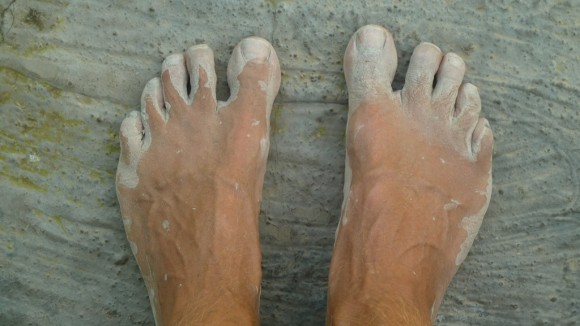
Moreover, the waters were surprisingly warm — though this also meant that leeches were still in season. I’d been told by some returning trekkers back in Kathmandu that this was the case. And though I’d never seen one, I’d always been squeamish about taking it in the hide from same. So I was kind of freaking out a little – but by the time I’d got on the trail and begun looking at the look-see, I’d more less forgotten about them. So when (I think it was on the third day) I chanced to look down and notice a fresh wound oozing with blood (here it is post-ooze)…
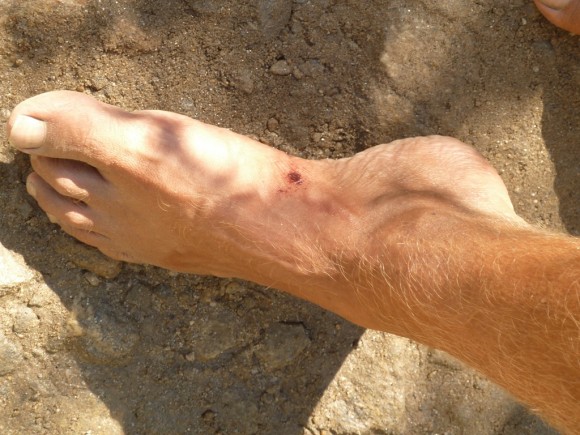
…I was pretty truly confused at the sight, recalling no memory of having gashed it, nor having felt even one whit of pain or discomfort. It was only when, a few hours later, I noticed more blood running – from the webbing this time – that I finally situated my thinking-cap just so, and sussed out the nature of the woundings. So, I kind of tried to proceed through the crossings more quickly, and didn’t suffer any more bites after that. But, really, I dunno – so long as they only go at you one at a time, every few hours or so, turns out leeches ain’t all that bad.
As for the rocks, assuming one weren’t attempting to barrel through and set a land-speed record, they weren’t quite on the Satanic side. The soles did become quite sore by the end of a day’s hike; but, next morning, they were ready to go again. Anyhow, the slow pace allowed me to enjoy the overwhelming scenery all the more.
It seemed even more beautiful than it had in the Spring. Maybe because the rains had only recently stopped falling, or maybe all in my head. Either way, that very same head was spinning too right. I had thought that – having already taken so many in the Spring – I’d perhaps spend less time taking photos, and more just living in the moment. But that thought was quickly forgotten, and I ended up keeping 750-plus shots from the trek and various day-hikings around Pokhara. They’re all there at the Flickr page, so feel free to go and have a gander. But for the current moment, we’ll see if we can refrain from getting too carried away here…
In the lower elevations, the Circuit is all about the Rice paddies, the butterflies, the massive rock formations, and the sun playing its way into the gorgeous gorges throughout the early-morning hours.
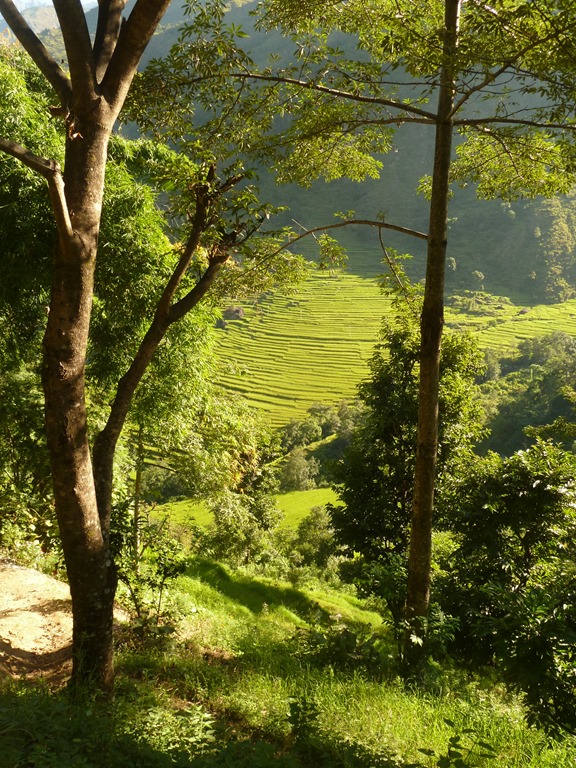
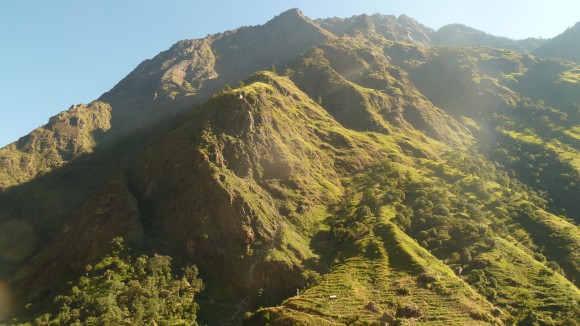
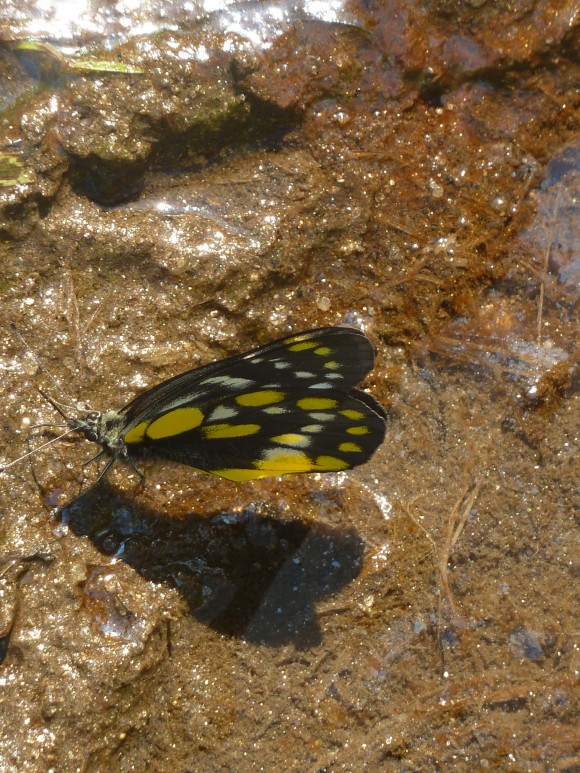 And, of course, it’s also about the Marsyangdi river and the insanely numerous waterfalls thrashing their ways from the tops of said gorgeous gorges all the long splash down to the river itself. Shoot-howdy, those three rivers that so totally and thoroughly rock my world – the Marsyangdi, the Mekong, and the Yellowstone – please don’t ever ask me to choose from among them, as I fear I’d end up sitting down in the road and having myself a straight conniption.
And, of course, it’s also about the Marsyangdi river and the insanely numerous waterfalls thrashing their ways from the tops of said gorgeous gorges all the long splash down to the river itself. Shoot-howdy, those three rivers that so totally and thoroughly rock my world – the Marsyangdi, the Mekong, and the Yellowstone – please don’t ever ask me to choose from among them, as I fear I’d end up sitting down in the road and having myself a straight conniption.
There’s a short-ish loop trail outside of Chamche featuring one of my favourite waterfalls; in which, the water is raging right underneath one’s feet. Arriving there, I sat down on a little log bridge and luxuriated in the sun for a good thirty minutes’ time and eating some Cucumbers (pretty sure this was the last day on which I was able to find any of these).

That’s the great thing about solo trekking: You can arise whenever you want, depart whenever you want, stop for the day whenever you want, keep whatever pace you want, and stop to take photos or gog the scene whenever you want and for as long as you want. And – at least during peak season – there’re so many trekkers on the trails and in the lodges, and so many villagers out and about, that you’ll never want for camaraderie – nor have to worry about being discovered should you fall down and bash your skull (or what) real good one. Count me a solo-trekking apostle!
Anyhow, back to the waterfalls. Here’re a few more gratuitous shots:
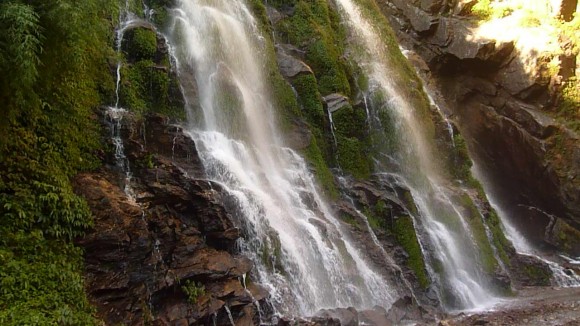
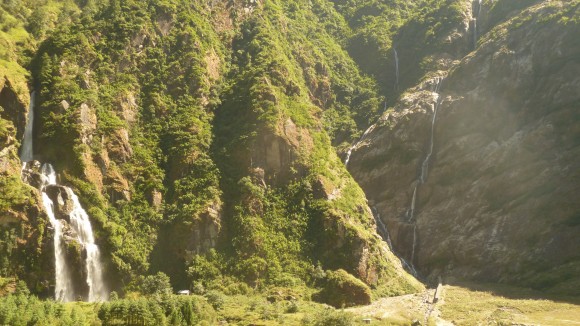
Also, I had it in my gourd that I wanted to make a video for the awesome Cloud Cult song “When Water Comes To Life”, so was busy collecting footage to purpose toward that end. I shot it in HD, just to be pretentious-like; and while this would come back to haunt me in the form of limited memory-card space and files too massive to upload using Nepal’s miniscule tubes, I did manage to cobble together the following. I’m not completely smitten with it; but I do think it’s an enjoyable enough four minutes.
·
From the second day, making the climb into Bahundanda:
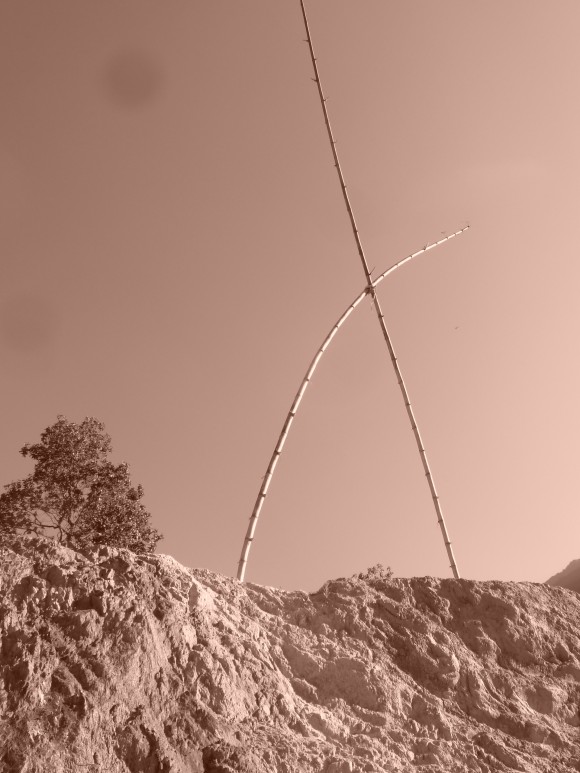
The Annapurna Witch Project? Nah, it’s the remains of the then-recently-completed Dashain festival, upon which I reported during my previous correspondence. Turns out, the citified celebrations are nothing like how they do things in the country. If I’d not heard all about it from some hostel-mates before departing, this sight may well have had me totally bamboozled.
What they do, they attach attach a swing to these uprights, get their dimpled asses as drunk as possible on rice beer, and then (standing rather than sitting, natch) swing those same dimpled asses up as high as they might – even ‘til they kiss the sky. At least so I’m told. Kids of all ages take part in the rite. But by the time, a week or so later, I reached the Rainbow Super View Hotel, near Chamche, the schoolchildren had eyes only for the teevee show.
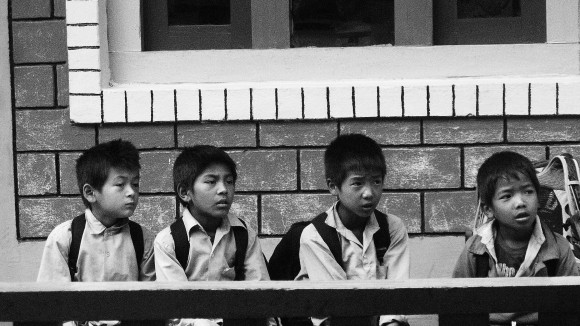
Yep, a few of the lodges are equipped with teevee screens and satellite dishes. That’s a few too many, in my estimation – but, I guess it’s not for me to say.
Speaking of Bahundanda, here’s a kind of a funny story. On my way back down, the second-to-the-last night of the trek, the only other guests in the lodge there in Jagat were a quite nice Australian couple on the way up, their second-to-the-first night of trekking. They were using a guide, a young-one of only nineteen years – whom, they had come to learn, had greatly oversold his familiarity with the trek.
Shortly after passing Ngadi, Annapurna trekkers are presented with an alternative: Either stay on the road, continuing on through Jagat and points upward, or branch off onto the trail climbing up to Bahundanda and Ghermu before descending back down and re-joining the road at Syange. They’d wanted to use the Bahundanda route, but their guide, insisting all along that he knew what he was doing, ended up getting them lost, and they’d had to backtrack for some time and ended up taking the road instead. So they never did make it to Bahundanda.
A real shame, because the lady of the couple was having a devil of a time pronouncing “Bahundanda”. She could always, eventually, spit it out – but, holy hell, it was painful to watch. Or rather, it would have been painful for anyone with a soul; myself, I found it deeply hi-larious. What was painful was trying to keep oneself from corpsing every time she began to steel herself for a new attempt – which attempts were shockingly frequent, in fact, even considering the central role Bahundanda played in their story. Gotta give her props, though, for never having tried to steer ’round its use, nor employing some kind of code-word, or what have you.
It’s all very strange anyway, because it’s so well marked that to find the conjunction-junction needs neither guide, nor map, nor even prior knowledge of its existence. Don’t know just what their guide had been smoking that day, but he’d definitely been smoking something.
•
Part 2: You Can’t Always Get What You Want
[dc]T[/dc]he trail through Bahundanda, as well as a similar diversion through the village of Tal, are much desired as they allow trekkers to avoid the road for large stretches of time. I voiced in the Spring my opinion that the road wasn’t nearly so bad as has been made out. But now in the Autumn, it was even less so than before. I couldn’t figure it out, really: Why were there so few jeeps and motorcycles? They were just…nowhere to be seen.
Finally, on my fourth day of trekking, I discovered the reason. A massive rockslide was covering the road between Chamche and Karte. There was one backhoe working at clearing the path, but until then, there were just a few jeeps on either side of the slide, with porters ferrying supplies from those arriving below to those waiting above.
Meanwhile, the walking trail over the slide was precarious as a motherfucker. Not for Nepalis, of course – but the latter have been blessed with magical feet and an equally nimble stride to accompany them with. I picked my way slowly through, however, until right near the end where there were two different routes one could take. A gentlemen was taking the lower, so I thought to take the upper and avoid having to cross his path. But I quickly became unsure of my ability to make the grade, and turned back to try the lower route instead.
Just as I was so doing, a Nepali gentleman of sixty or so years arrived out of nowhere and offered to take my backpack across. “No problem,” he kept repeating over and over. Almost before I could get the straps unlatched, he’d grabbed the pack with one arm and teleported to the end of the slide. Even without the pack, I still had to take it slow and unsteady. But, eventually, I did make it to the other side as well.
The Nepalis in the slide area were much less interested in my difficulties navigating the obstacle course, and much more interested in my bare feet. The same was true everywhere, of course: Nepalis and trekkers alike – to the very last person – stopped to ask me about my bare feet. One of the former assured me that my barefoot ways were “very Nepali”, but every single other one of the former conveyed to me that I was completely, asininically, ridiculously, locopants motherfucking crazy.
The foreigners felt more less the same – though they did at least give me respect for making the effort. One Frenchman asked straight out, “Are you crazy?” After I answered in the affirmative, he began making his way down the trail, and stumbled and fell into a rock wall. Looking back with a sheepish grin on his face, he offered, “Even when we’re wearing shoes, we still can fall down!”
Everybody, foreigner and local alike, wanted to know why. Why was I doing it? But try as I might, each time asked the same, to plumb the depths and return with some kind of sagacious or existential burst of Meaning, the only response with which I could ever come up was, “Because I want to.”
Shortly after the slide, however, the road becomes exceedingly rocky – even by rocky mountain road standards. Really, I didn’t want-to any more. Oft tempted as I was, though, to just finally throw on some shoes, I kept to the unshod path. Finally, with a few hours’ hiking remaining in the fourth day, I decided that the unshod path was affecting my enjoyment of the trek. What should have been one of the great life experiences was becoming a drag. And so, at last, I bent over and slipped on my shoes.
As soon as I did so, it was like a great weight lifted (Dr. Nusbaum was right). It was like a revelation, almost. Why indeed? Why had I been so stoopid as to try the Circuit barefoot? What had I been trying to prove? How foolish can one human person possibly be?
One’s enjoyment of the Circuit is, for sure, infinitely the greater whilst wearing shoes. The truth of the matter is, however, that after checking in to a destination each day, I was always eager to kick off those shoes. Shorn of backpack, I daily went traipsing merrily bare of foot over these very same rocky expanses which would have so horribly bedeviled me mere moments before, singing, “Tra-la-la, ain’t life grand?”
Conclusions:
-
Human persons are meant to live their lives barefoot.
-
Human persons are not meant to live their lives barefoot whilst humping twenty-five pounds of backpack over endless rows and columns of jagged-ass rock.
•
Part 3: Stuck Inside Of Chame With The Pisang Blues Again
[dc]T[/dc]he first sign that anything might be amiss came when I was checking out of my lodge in Danakyu. I thanked the proprietress for the hospitality (my third time staying at this particular lodge, and they always remember me and offer a warm welcome), and she told me, “If it rains, maybe a little cold. Otherwise, no problem.”
Her advice slightly unnerved me. Why would it rain? Rainy season was supposed to be over, wasn’t it? I made for Chame, her words still ringing in my head. Not to make too much of it, but, I do rather dislike hiking in the rain – especially in cold rain, as it would be now above 2,000 metres of elevation.
At the very least, the overcast had marred the beauty of the hike between Danakyu and Chame. It’s still pretty great, no doubt…
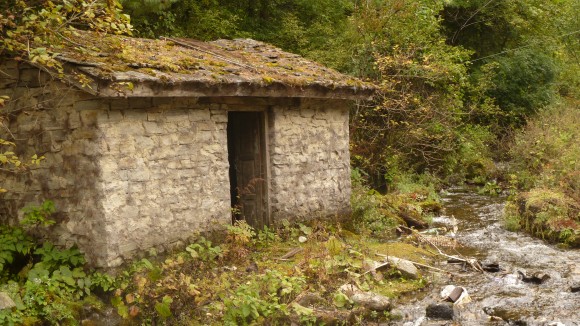
…but even at that, I found myself not wanting to linger too long in any one place, lest I get caught out. I mean, I did have raingear and all, but I didn’t want to have to use it. So, not so long after purchasing some delicious Apples purchased by the side of the road from a very nice old lady (from Chame up to Manang is prime-time Apple-growing country, and they were prime-time in season), I arrived in Chame at about 1:00 in the PM.
Wanting to find a lodge right next to the river (most of the villages are situated some distance above the river, but in Chame it runs right through town), I initially passed by another very nice lady – this one chopping wood by the side of the road, and begging me to bed down in her lodge for the evening – on my way into town. But something niggled at my barely-there conscience, I turned around and looked at her, and the lodge, and thought, “Well, what the Hell?”
I checked in at the Snowland, and, right inside of the Dining Hall – What do you know? – ‘twas a hen-in-the-house.
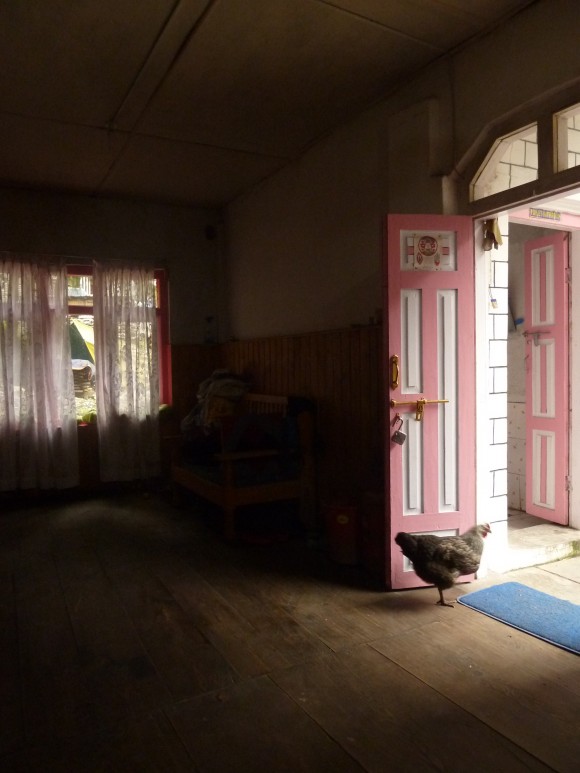
Yes, I was going to like this place.
I went up to eat my Apples by the river — and after chatting for a while with some hostel-mates from back Kathmandu, who’d stopped for the night a few lodges above my own, sat down and did exactly that. Couldn’t believe how incredibly beautifully turquoise the river was now, and made a note to myself to get a picture of it in the morning, when the sun would be shining bright.
Later, eating dinner by my lonesome – same victuals as every night, either plain Rice or boiled Potatoes – I thought that it was good that I’d stopped at this lodge, as it looked like it otherwise would have been guestless for the evening. But just as I was finishing up, a group composed of an Indonesienne (name of “Dewi”) and two Germans (names of “Peter” and “Johanes”) showed up as well.
After a brief exchange of pleasantries, I went off to go to bed, and as I left the Dining Hall and climbed the stairs toward my room, I felt a few pings of water hit my face. “Ah, so perhaps it is going to rain after all,” I thought. It had been cloudy and quite cold all day, but the threats of rain had ‘til now proven empty. I fell asleep to one of my favourite sounds: The pitter-patter of raindrops on a wooden roof…
…And woke up to the very same pitter-patter. When trekking, the sound is not nearly so appealing in the early of the morning as it is in the late of the night. By 8:00 in the AM, it had become readily apparent, though, that there would be no trekking on this day. And so that was the crew that rode out the storm: Myself, Dewi, Peter, Johanes, their guide, our hostess (never did meet her husband – apparently he leaves very early in the morning, and returns quite late at night), her ten-ish-year-old daughter with the mad dancing skillz, and her eight-ish-year-old twin sons.
A gloriously magnificent crew with whom to be stuck in for the day. My one truly great regret from the entire trek is that I neglected to get a picture of the all of us together. Turns out, too, that ol’ Peter was probably the only person rounding the Circuit with an even more bizarre and wretched diet than mine own. Owing to allergies and some manner of kidney issues, he’d had to pack his own food in with him. Namely, dried or smoked snausages he’d brought from Germany, and packets of crackers he’d got in Kathmandu. The latter he crushed up and stirred into a nudge glass filled up with boiling water dispensed from a gleaming-white thermos.
We spent the day alternately freezing our dimpled asses off inside the Dining Hall and trying to warm up under the covers back in our rooms. At one point, Johanes did don some gear and go purchase a candy bar. And, amazingly enough, there were trekkers making their ways into the village throughout the day. Johanes later said that he’d counted about thirty of them in total. Crazy fucks. Why subject oneself to hiking in the cold rain?
It was coming down, too. Never like, really really coming down – but also, never seeming to slack off from its constant, soaking downpour. So it was a second night of pitter-patter. But when I woke up at around midnight to use the head, I noticed that the rain had stopped. I estimated that it had rained for about thirty hours straight, then went back to sleep.
•
Part 4: Magic And Loss
[dc]N[/dc]ext morning, the sun was shining bright, and it was time to trek! There would be no pictures, alas, of the impossibly-turquoised Marsyangdi River. It was now, instead, a roiling, boiling, muddy mess. Drat.
I figured that the road would be pretty muddy in places as well. Which it was. But otherwise, all was good. The sun was shining, and the trail was filled to bursting with stir-crazy trekkers who’d been cooped up all day and night and were itching like craziness incarnate to again kick theyselves into the good mode of the old heel/toe. The river, in its muddified state, may not have been much to look at. But the mountains…yeah.

I caught up to the threesome in Bhratang. Everybody else was there, too. It’s the very heart of the Apple-growing region – the trees were groaning with fruit – and the village’s one and only lodge is renowned for serving the finest Apple Pie of the entire trek (the latter has been whimsically dubbed the “Apple Pie Circuit”).
When Kieran and myself had passed this lodge in the Spring, there’d been one lonely diner seated in its patio. To-day, they were hanging out of the rafters. And lounging by the side of the road. And mobbing with their orders the insufficient staff. On offer is every kind of Appley concotion one could imagine – but also just Apples, too. As local and organic as it can get; and, yes, these ones did live up to their reputation.
The threesome soon made to depart while I lingered on to finish my Apples and enjoy the ambiance of the throngs of giddy trekkers high on Apple Pie and the sun’s beaming rays. Just as I was fixing to leave, however, it all began to crumble. I noted a trekker coming down the hill, with his guide, and asked him why he was heading in the wrong direction? Had I not heard, he wondered? No, I had not.
Twenty-five missing outside of Manang, he insisted. Twenty below at Thorung La. Three feet of snow on the ground at Upper Pisang. “Holy crap!” was the most edifying response I could find. I’d, of course, expected that all that rain down in Chame would have been falling as snow higher up the hill, but…Holy crap, man.
On my way toward Dikhur Pokhari, I continued to ply with queries those trekkers who’d turned around and begun to head back down. And swiftly the rumors began to mount – to this day, I don’t know which were true, and which not: Four Israelis had been killed. Thirty-five feet of snow at Thorung La. One Israeli trekker had rescued three other trekkers. Scores of trekkers were trapped at Tilicho Base Camp. Nine people killed in an avalanche at Thorong Phedi. No, it was eleven people, and they were killed just the other side of Thorung La. Or had there been two killer avalanches?
And hearing these rumors, one begins to wonder: What if I had not been playing at barefoot, and had made better time in the lower elevations? Or what if I had not been so paranoid about getting sick again, and had not intentionally cut off my days early so as to avoid ascending too quickly?
But also: It’s crazy enough to be trekking in the rain; who in their right mind would possibly go out in the snow? It then occurred to me that there were not only those trekking the Circuit itself here in the region, but also those making expeditions – i.e., using well-known and -maintained trails, but without the tea-house infrastructure – as well. My mind then quickly turned to the Germans.
At the Rainbow Super View in Chamche, I’d met two German dudes who’d been part of a group of seven trekkers, two guides, and four porters. They’d not liked their own lodge, so had come up to the Super View to drink beer and gog the waterfall. Very nice and friendly guys, with whom it was quite good fun to be speaking.
But they were quite derisive of my beloved Annapurna Circuit, claiming it was too easy, and too touristy, and that all the lodges’ menus were exactly the same, and so on and so forth. So they were, instead, soon to branch off the Circuit and make a four-day expedition to some peak in the Manaslu range. The trekkers were packing all their own gear, while the porters were carrying the camping and kitchen supplies along with the food.
I don’t know whether it was four days in and four days out, or four days total. If the latter, I think they’re probably okay. But if the former, then… I never did catch their names, so have no idea how they have fared. I did hear that the Manaslu area got hit particularly hard.
Two others about whom I wondered, whose names I did know, were the bicycling Brit name of “Steve” and Virginian name of “Mike”. I’d lodged with them in Karte, a few days before arriving in Chame. Steve is in the fifth year of a world cycling tour, and Mike in the second. I guessed they would have been around about Manang when the storm hit – and turns out I was right: Read Steve’s wonderful account of his and Mike’s time in the Circuit. His writing is so good it almost makes me never want to set pen to blog again.
I did later hear, by the way, that it wasn’t so much campers that had gotten whacked, but more people who’d gone out the morning of the snow, usually at lodge-owners’ insistence that it’d not be a problem (but also, so I heard, against their guides’ advice). Again, I really don’t to this day know truth from rumor.
Anyway, it was all quite mind-boggling to say the least; and also surreal, the rumors such a stark contrast to the colossally gorgeous panoramas the storm had wrought. Just two days before, these had all been snowless scenes…
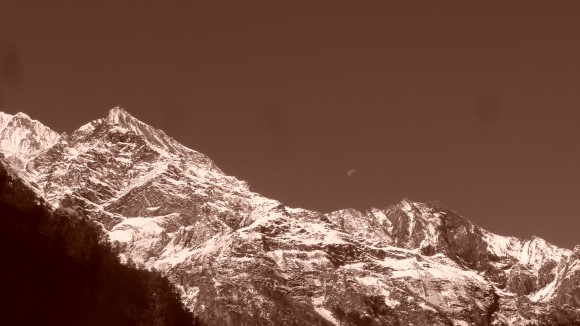
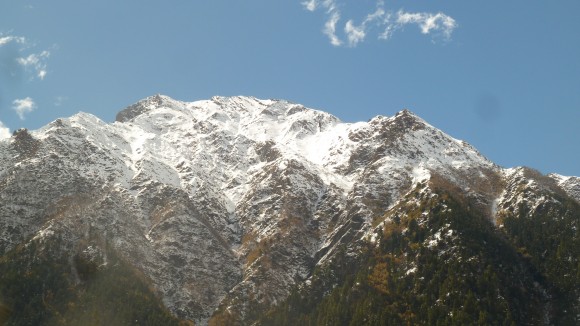

At Dikhur Pokhari, the scene was similar to the one in Bhratang: All the lodges’ patios were packed to “Full” with noonday diners. Almost all of them would be moving on to either Upper or Lower Pisang. I’d be staying here, however, so when I bumped into my Alobar friends again (an Alabaman name of “Ben” and an Australian name of “Tom”, along with some French girls with whom they’d been hiking), I checked in to the lodge at which they were lunching, pulled off my shoes and shirt, and sat my dimpled buttocks down upon their very nice rock wall, soaking up the rays and shooting the shit.
Unlike in Bhratang, the rumors had already begun to reach the trekkers here in Dikhur Pokhari. So the mood was much more on-edge than it had been in the former. People seemed more or less to be taking it in stride, however.
Among those heading up the trail were my friends Dewi and Peter. I’d passed them during the climb up toward Dikhur, and would now say goodbye to them, as they were trekking on to Lower Pisang. Johanes had made fast pace after Bhratang, so I never did see him after that – though I did run into Peter again in both Kathmandu and Bhaktapur. Off the trekking circuits, he was no longer eating his snausages and crackers, but had instead reverted to “normal” food.
There were also people heading down the trail, of course, including a completely mental Canadian family. It was a dad, a mom, and two of the most precocious pre-teens you’ve ever seen in your life. They’d hiked the Manaslu Circuit, and after having finished that had thought to head up to Manang for a few days, just for shits and giggles – so, their descent had been pre-planned, and was unrelated to the storm (though not unaffected by it, as the hike from Manang to Pisang was on that day very snowy and slushy).
The father was wearing a, like, scout uniform; and the family had just finished reading Roots aloud together – the mom even having employed a southern accent when appropriate. They’d stopped here to dry the daughter’s socks on the rock wall, and to eat chocolate cookie. They took a keen liking to yours truly as, being from Vancouver Island as they are, we’re practically next-door fuckin’ neighbours. (Also, the mom appreciated it when I corrected the daughter’s English at one point. I was just horsing around, really — but you know how moms are…)
After keeping us thoroughly entertained for fifteen minutes or so, they made for Bhratang and its legendary Apple Pie. No sooner had they begun their departure that the dad let out a great war-whoop and took off running at full gallop right down the hill, the family following his lead to a T. In that moment, it was just about all I could do to prevent myself chucking Thorung La altogether and running after the family to ask whether I could make a documentary about them.
The diners eventually moseyed on, and after performing my daily post-trek stretching routine, I went and explored a beautiful big meadow a bit outside of town. There were some areas of slush on the road, which were certainly cold to walk through – but the cold was more than made up for by the brilliance of the warm, wonderful mud which followed.
In the meadow, the birds and butterflies were in full force; and the mountains — oh, my god, the mountains…
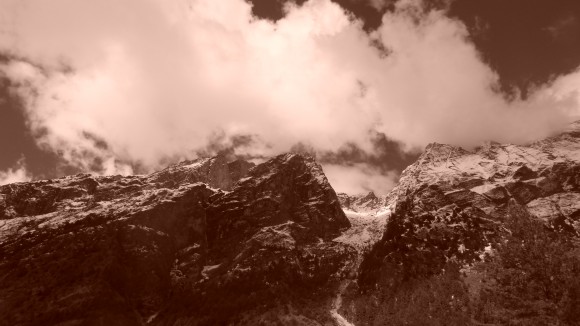

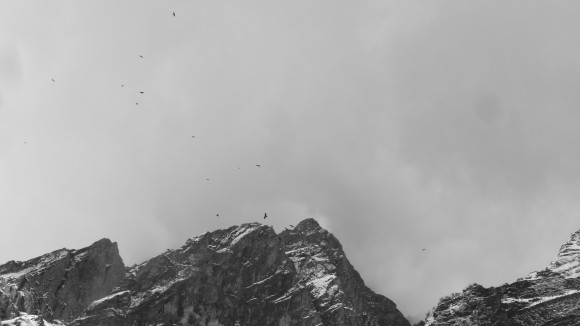

As the afternoon sun started really making its presence known, the valley began to reverberate with the sounds of avalanching snows. They would occur every half-hour or so at first, but near to evening time, the frequency had increased to about one every five minutes. I did manage to catch a few seconds’ worth of footage. May not look like much, but believe you me: When that rumble forces its way into your noggin’, it’s most spookifying indeed.
·
Even freakier than that, though, would be what replaced those reverberations over the next many days – viz., the reverberations of rescue helicopters making up and down the valley. Apparently a common sign on the Everest Base Camp trek, they’re (usually) virtually unknown on the Circuit. Yikes, there were so many of them.
•
Part 5: You’ve Got Arms, And You’ve Got Legs, And You’ve Got Heaven
[dc]N[/dc]ext day, I made the short two-hour trek to Upper Pisang, site of my demise back in the Spring. This second day’s sceneries were every bit as impressive as had been those the first day after the storm.
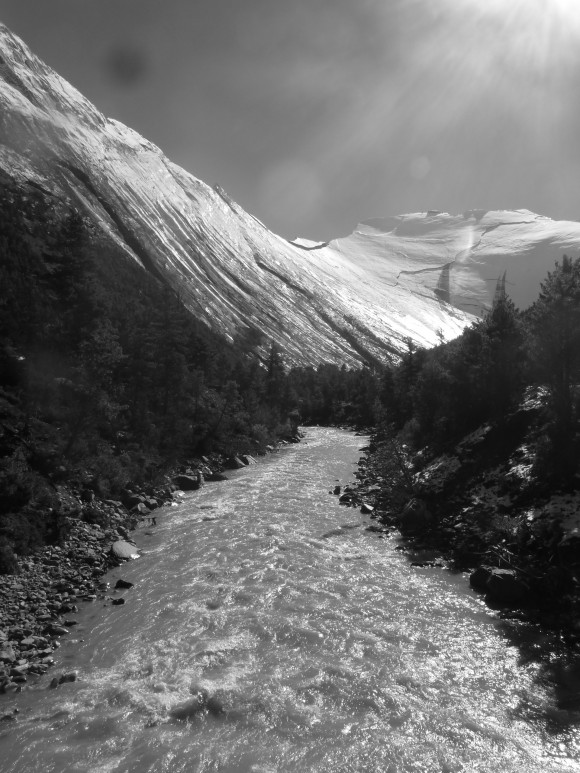
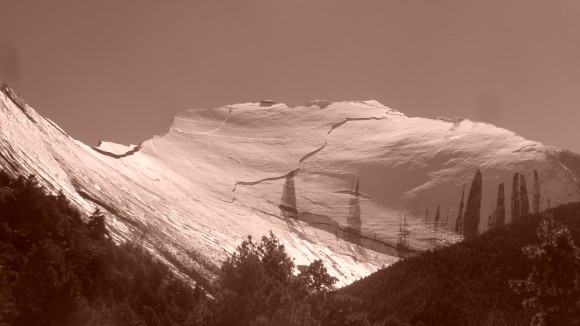
That ginormous rockface is known as the “Gateway To Heaven”: Nepalis believe that the souls of the dead must climb up to its summit before proceeding to their destination. At any rate, when we were here in the Spring, it had held nary a flake of snow.
I checked in at my favourite lodge of all time, the Yak And Yeti. Rather than spending the entire time in bed there, though, I was on this occasion free to go and explore Upper Pisang. Not so easily accomplished now, though, as the place was (this rumor at least turned out to be true as blue) buried in snow.
A bit of a blessing, as it happened. I’d been filling my water bottles with river-water after ascending upstream of the ghastly Chinese dam-construction project near Ngadi (still hasn’t been blow to smithereens, more’s the pity), but here, there were no rivers to be found. So, I filled the bottles up with snow instead. Apart from taking a long time to melt, this worked out just fine. Indeed, the river water tastes like snow anyway, when cold. (When warm, it just tastes like delicious water.)
The prayer wall was accessible enough.
 Climbing up to the village’s famous temple was a bit more challenging, but worth the effort. Some of the paintings in there were pretty far out, too.
Climbing up to the village’s famous temple was a bit more challenging, but worth the effort. Some of the paintings in there were pretty far out, too.
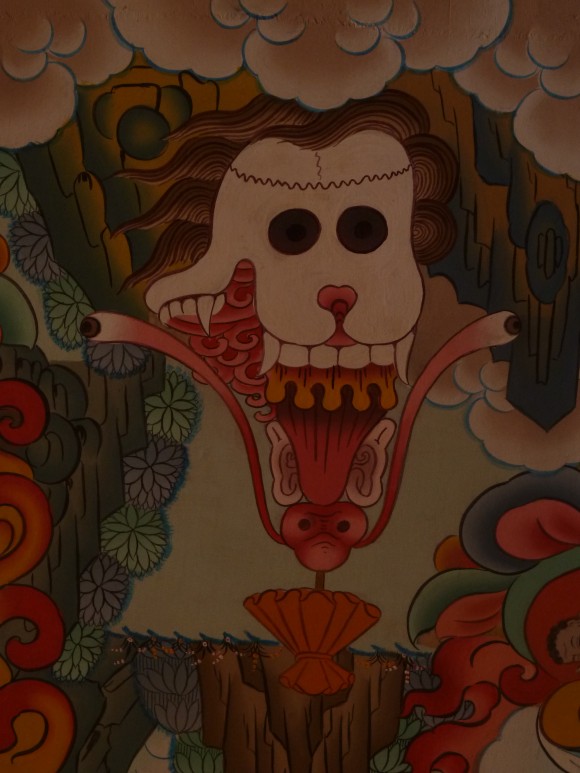
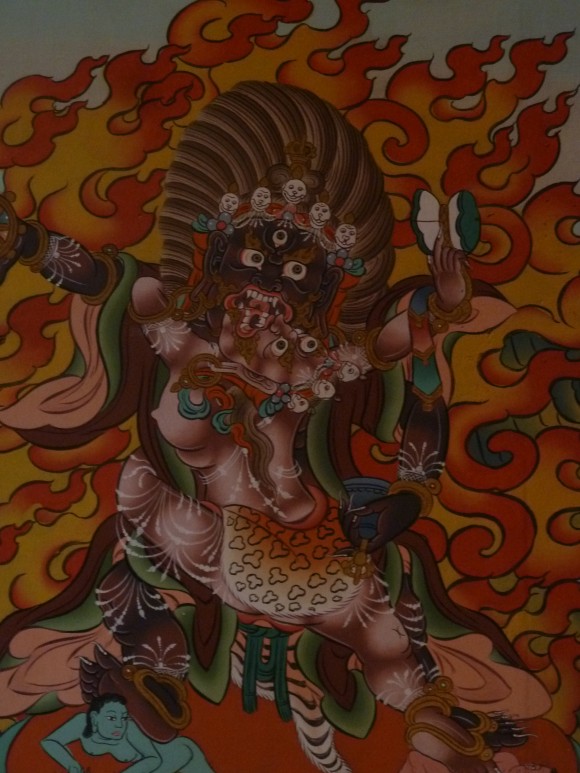
I sat down on a stump to eat some Apples and gog the mountains, and the gentleman on the far right here…

…came down to hang out with me. I offered him an Apple, but he refused on the grounds that being one of the temple’s caretakers entitled him to as many of its trees’ Apples as he pleased. Turns out he has a currency collection, and wanted to trade me for some American dollars. I hadn’t any in my billfold, though – only some left over Thai Bhat. These he was eager to trade for also, so I did the conversion in my head, and we made the exchange. I later got the feeling that I’d gypped him, and breaking out the calculator, confirmed that I indeed had done. Gypping a Buddhist temple caretaker…what miserable hand might fate deal me now?
Hiked, then, up to the very top of the hill; which was beautiful enough for twenty…
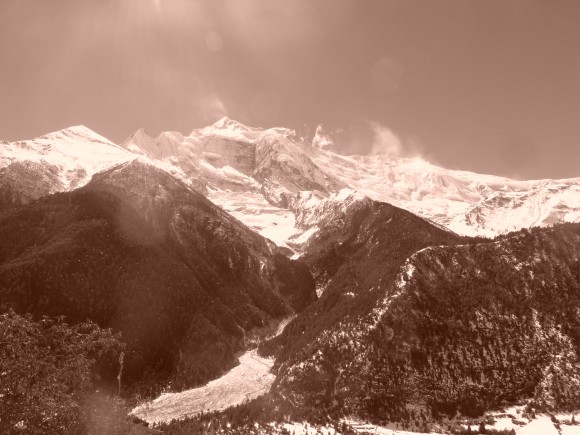
…though there were many places were a path through the snow had not yet been established, so I ended up getting good and soaked. A good excuse to lay about atop the lodge’s sundeck. The snow had reduced the number of people out and about virtually to zero. So, rather than sit there inside in his infamous aerie and cajole the passers-by, bossman was content to join me on the roof, alternately napping and playing with his grandson.
 That night figured to be much less lively than previous nights spent here, considering the only guests were myself, a Japanesian couple, and their guide (apparently, the night before there had not been a single vacant bed in the entire village). The locals soon arrived, however, for a fine birthday celebration. It began in the kitchen with the drinking of many beers and the singing of the traditional birthday song; to be followed by the singing of every other song in the history of the Nepali language. Nepalis love to sing – which doesn’t necessarily mean that they know how to sing. I’d loved to have taken some footage, but, being that none of the lodges had any power after the storm, I wanted to preserve my camera’s batteries’ juices for the capture of photographic evidence instead.
That night figured to be much less lively than previous nights spent here, considering the only guests were myself, a Japanesian couple, and their guide (apparently, the night before there had not been a single vacant bed in the entire village). The locals soon arrived, however, for a fine birthday celebration. It began in the kitchen with the drinking of many beers and the singing of the traditional birthday song; to be followed by the singing of every other song in the history of the Nepali language. Nepalis love to sing – which doesn’t necessarily mean that they know how to sing. I’d loved to have taken some footage, but, being that none of the lodges had any power after the storm, I wanted to preserve my camera’s batteries’ juices for the capture of photographic evidence instead.
The party soon moved on from the kitchen to the Dining Hall, for yet another round of singing and drinking. Eventually it ended as all evenings (in my experience) at the Yak And Yeti must: with drunken fisticuffs. As is apparently a nightly occurrence here, the bossman finally had to come down and throw the drunken louts out into the cold night, and locking the door behind him. If you never in your life get to experience an evening at the Yak And Yeti…oh, but pity you I most surely do.
The high route to Manang is considered the more preferable option both because it offers the finest views of the entire trek, and because it greatly aids the acclimatisation process. The climb up to Ghyaru, though, is one of the trek’s most notorious. The two-hour hike from Upper Pisang to the base of the climb is pleasant enough. But, after crossing a suspension bridge over a cascading river, the climb is on.
It’s no worse, really, than similar climbs into Bahundanda, Tal, and Timang – except that it’s at altitude (Ghyaru sits at 3,700 metres of elevation). It means: Too much the huffing, and too much the puffing. Thankfully, most all of the switchbacks are decked out with nice rock walls upon which to plop one’s dimpled cheeks and catch a breather or three. Believe you me, when they weren’t covered in snow (the rocks, I mean – luckily, my dimpled behind had not found its way onto the ground), mine made their way to nearly every single one.
Not to say it wasn’t shockingly gorgeous, because that it most certainly was…
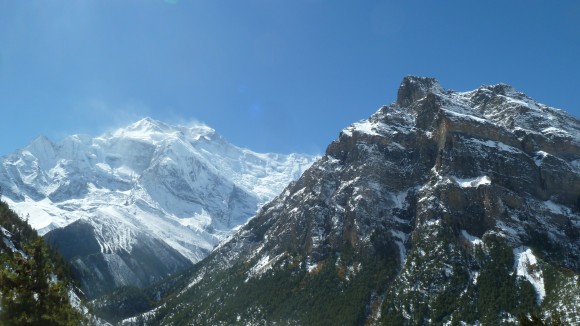 But so difficult was the climbing that, had I not access to any frame of reference, I’d have guessed myself to have been struggling more than might be considered normal. But as it happened, I’d been hiking much of the way from Pisang with a friendly Indian trio. And, poorly as my performance seemed to me to be going, I very soon left the trio far behind, and then caught up to a very friendly Korean couple. The male of the couple was intensely interested in my shoes (he’d heard of them, but never seen them in person), even requesting to take of them a photo — which request was happily granted.
But so difficult was the climbing that, had I not access to any frame of reference, I’d have guessed myself to have been struggling more than might be considered normal. But as it happened, I’d been hiking much of the way from Pisang with a friendly Indian trio. And, poorly as my performance seemed to me to be going, I very soon left the trio far behind, and then caught up to a very friendly Korean couple. The male of the couple was intensely interested in my shoes (he’d heard of them, but never seen them in person), even requesting to take of them a photo — which request was happily granted.
I left them behind as well, and at very, very long last, reached the summit. The very first structure on the way up is a tiny little restaurant whose owner is a shockingly insistent pusher of black tea. I had to tell her no fewer than twenty different times that I didn’t want any black tea, and still she refused to believe that I could possibly be telling the truth. Finally, I bought a couple of Apples from here, which seemed to shut her up for a little while.
I was happy when the Koreans, and then the Indians showed up and did want black tea, as it took the pressure of myself to be buying some. The Koreans then busted out their own god damn pocket burner to boil some water for the noodles they were packing.
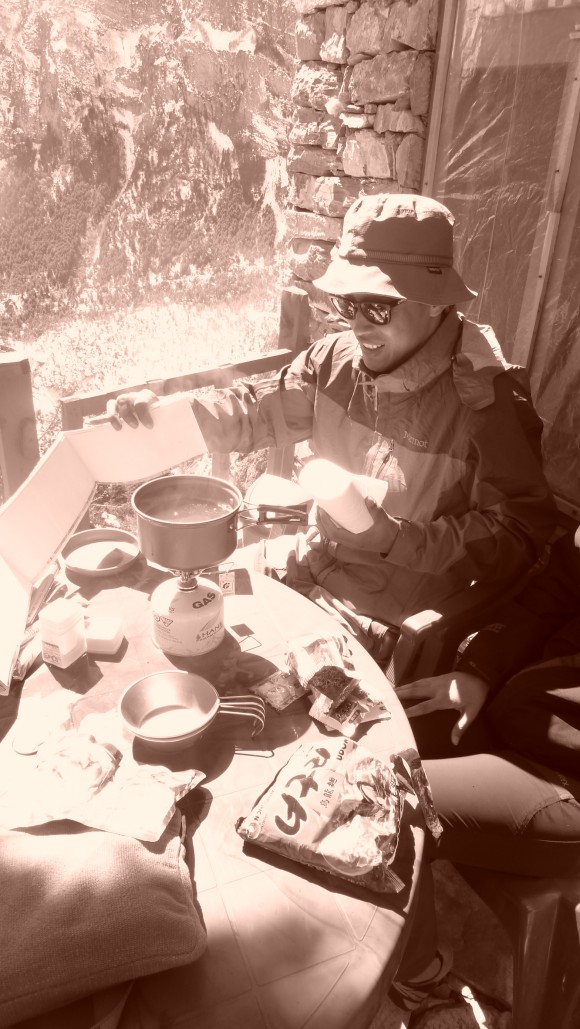
The owner’s teenaged son was up on the rooftop shoveling snow with a huge wooden spatula, so I climbed up the ladder to have a look around. No sooner had I peeked my head above the roof, that he was asking would I help him in the shoveling, being that he was very tired.
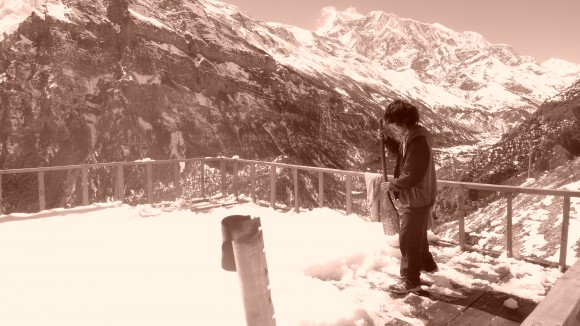
“You think you’re tired?” I rejoined, incredulous, pointing down to the river, barely visible far, far below. “I just hiked my dimpled posterior all the way up here from that river – I’m the one who should be tired!” I finally relented, though, when he assured me that my helping him would bring me good luck. He quickly demarcated the area he expected me to clear, and showed me the technique – this involved breaking off cube-shaped chunks of snow, then scooping them up and flinging them over the rail.
And it was actually pretty fun! If they’d had lodgings there, I’d have offered to shovel the whole damned roof in exchange for a bed, a blanket, and a gigantic plate o’ spuds. As it was, though, I continued on up to the village, and checked in at the Yak Ru (“Ru” is the Nepali word for “horn”). With Swastikas lining the walls (always a bonus)…
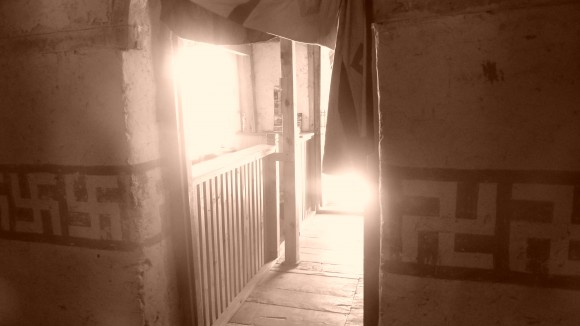
…and an excellent room – a low ceiling and lots of windows, just the way I love it – I could tell this would be a fine place to stay.
I washed my shoes (the road had been pretty slushy in places), and hung them up to dry…
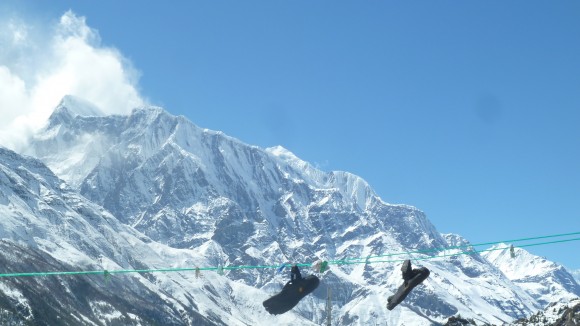
…and, after finishing my stretching routine, sat down to talk with the owners’ son (that’s him on the left, there).

We talked about Jimi and Kurdt for a while, but he soon turned our attentions to the only subject on anybody’s minds. He said that in twenty years, he’d never before seen such a deep accumulation of snow from a single storm. He then began listing off the numbers of people who’d been killed, by region – except that, rather than using the word “killed”, he every time used a throat-slitting pantomime instead. That was pretty unsettling.
As shocking as casualty figures like those from this storm may to-day to us seem, however, I couldn’t help thinking: Welcome to the future. A rogue, out-of-season storm dumping more snow than the locals have seen in twenty years’ time – wanna try to tell me that ain’t climate-related? The weather’s already plenty haywire enough. But I’ve a feeling that in five or so years, storms such as this one, and the recent event in Buffalo, along with the Sandys and Katrinas et al., will be arriving with such head-spinning frequency that they will hardly even be news anymore.
For now, though, I just kept gogging in disbelief at the mountains playing out before me. While pinching myself to make sure it weren’t all a dream, I recalled the words of the very first person to tell me of the existence of the Annapurna Circuit, an Angeleno I met in Luang Prabang in 2012 (yes, it’s true: I’d never heard of the Circuit before then – I’ve lived rather a sheltered life). While looking at his pictures, he in hushed tones allowed to me that he “still can’t believe I was there.”
Looking at the scene, I could more less believe I was there. What I couldn’t, and can’t still, believe, is that such a place even exists in the first place. A scene made all the more impressive by the very storm which had taken dozens of lives and, so it seemed, scotched any and all chances of my making it up to Thorung La. The Himalaya giveth, and the Himalaya taketh away…
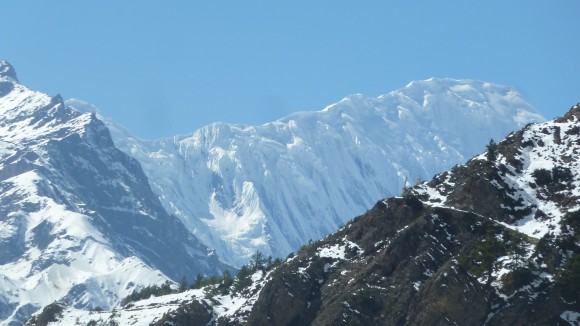
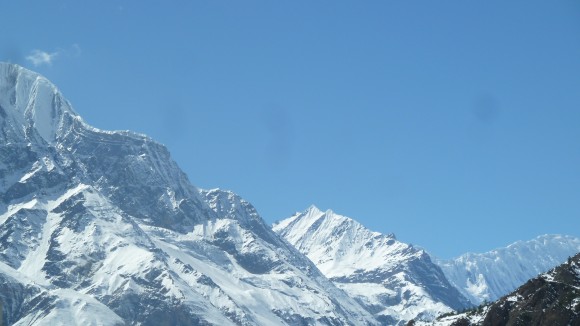

Eddie ,
This is exactly what I expected from you ! Read the whole thing non-stop . Fantastic !!
Thanks a bunch for sharing ! Keep up the great work !
Love & Hugs , Aunt Becky
So glad you like!!
I am not sure Becky read your whole post…….
But she is right. Fantastic.
By the way, thanks for being predictable. I studied the route you were on and re-read your last post a few times and predicted, due to your bare feet, that you were safe in Psiang. Was extremely doubtful that you would have made in to Manang. 100% didn’t think you made it to the Pass.
Welcome back to the world and can’t wait to see your dimpled “cheeks”.
Ah, if only I could teleport myself back home for the holidays and the NFL Playoffs, then teleport back here ’til Summer.